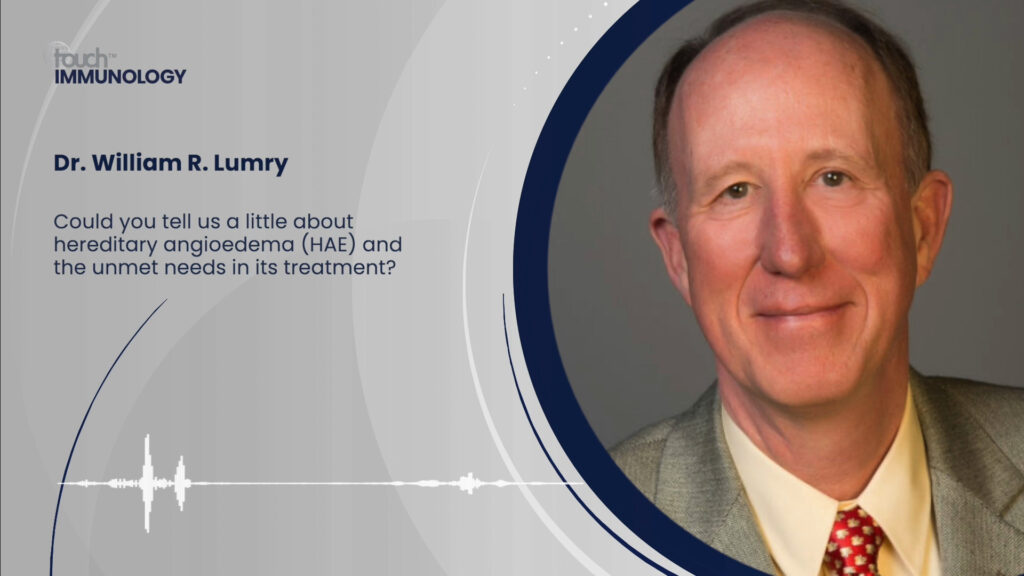Ligelizumab is a monoclonal antibody recently investigated in the phase 3 PEARL-1 and PEARL-2 studies for the treatment of chronic spontaneous urticaria (ClinicalTrials.gov Identifiers: NCT03580369 & NCT03580356). In this touchIMMUNOLOGY interview, we spoke with Dr. Luis Felipe C. Ensina (Federal University of São Paulo, São Paulo, Brazil) around the rationale for investigating ligelizumab in this indication, the methodology and findings from the PEARL-1 and PEARL-2 studies and the next steps for ligelizumab.
The abstract ‘Efficacy and Safety of Ligelizumab in Chronic Spontaneous Urticaria: Results from the Phase-3 Pivotal Trials.‘ (Abstract number: 402) was presented at AAAAI 2023, February 24–27, 2023, #AAAAI2023.
Questions
- What is the rationale for investigating ligelizumab in this indication? (0:24)
- What was the methodology of the PEARL-1 and PEARL-2 phase 3 studies? (1:25)
- What were the efficacy and safety findings from the pooled data of both studies? (2:08)
- What will be the next steps in the clinical development of ligelizumab? (4:05)
Disclosures: Luis Felipe C. Ensina discloses consulting for Novartis; serving on advisory boards for Abbvie, Novartis and Sanofi; receiving honoraria from Abbvie, Novartis and Sanofi; and participating in Speaker’s Bureaus for Abbvie, Novartis, and Sanofi.
Support: Interview and filming supported by Touch Medical Media Ltd. Interview conducted by Victoria Jones.
Filmed in coverage of the American Academy of Allergy Asthma & Immunology Annual Meeting 2023.
Click here for more content from Luis Felipe C. Ensina.
Transcript
What is the rationale for investigating ligelizumab in this indication? (0:24)
Omalizumab is an anti-IG antibody, which is very effective for chronic urticaria. Ligelizumab, in theory is a more specific and more powerful anti-IG antibody. And on phase 2 studies, the efficacy of ligelizumab was superior than omalizumab when treating patients with chronic urticaria. So, in theory, again, using ligelizumab should be better than omalizumab. In other words, maybe those patients who were unresponsive to omalizumab or who were partial responders to omalizumab could benefit with this new drug, which is more potent than the previous one.
What was the methodology of the PEARL-1 and PEARL-2 phase 3 studies? (1:25)
Both studies PEARL 1 and 2 were identically designed randomized, double-blind, active and placebo controlled parallel group studies with a 52-week treatment period and a 12-week follow up. Patients who were refractory to antihistamines, patients with CSU over 12 years of age were randomized to ligalizumab 72 milligrams, ligalizumab 120 milligrams, omalizumab or placebo subcutaneously every four weeks for 52 weeks.
What were the efficacy and safety findings from the pooled data of both studies? (2:08)
The efficacy was measured by observing the change from baseline in the urticaria activity score in seven days at week 24 (UAS7). So, when we look for those data, we see that in average the reduction in UAS7 was around 21 points for both doses of ligelizumab and omalizumab and 11 points for placebo. So, both ligelizumab and omalizumab were superior to placebo, but they showed the same efficacy regarding reduction in UAS7. When we look at the complete responders, in other words, UAS7 equals 0 at week 24 ligelizumab 72 was around 38%, 120 milligrams 42% and omalizumab 43% of patients reached UAS7 equals zero and just 7.2% in the placebo group. Regarding the safety outcomes, the main adverse event reported by the patients was headache around 8% in all the groups, including placebo. Placebo was 6%, a little bit lower. But what we could observe is that the drug is very safe. The ligelizumab, the results regarding safety were very similar with those in the phase 2 studies and very similar to those that we can see with omalizumab in real life practice.
What will be the next steps in the clinical development of ligelizumab? (4:05)
Because of this lack of superiority when compared to omalizumab, we were expecting much more from ligelizumab. That’s the truth. But because the results showed that both drugs are equal in terms of efficacy and safety and didn’t reach the primary outcomes, the company decided to stop the development of ligelizumab for chronic spontaneous urticaria. They are still developing for other indications. And we hope we can see new drugs coming during the next few years for those patients who are not good responders for the drugs that we have in our clinical practice today.
Subtitles and transcript are autogenerated.









